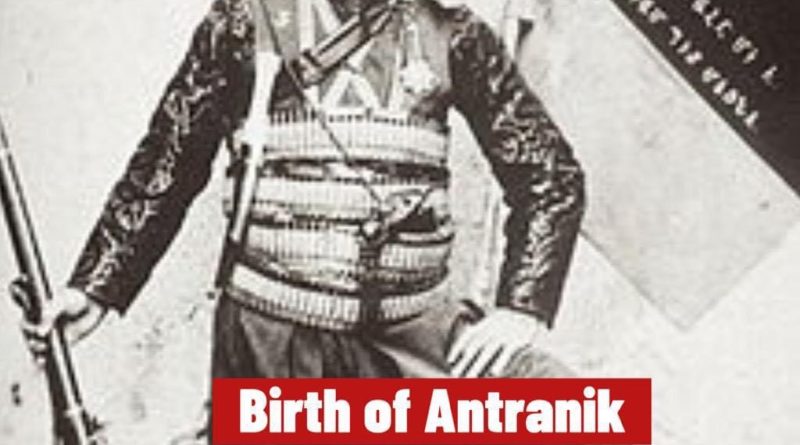Birth of Antranik, armenian fedayi chief, Turkish Army’s nightmare
Antranik Toros Ozanian was born February 25th, 1865, in Chabin-Karahissar.
At the age of 17, he was incarcerated for the assault of a Turkish policeman who abused Armenian people, but with the help of friends, he escaped from jail.
In 1892, he is arrested again for his participation in Constantinople’s chief of police murder, Yusuf Mehmet Bey, an Armenophobic man. Antranik escapes again from jail. Went through Hentchak then Dachnak parties, he defended Armenians villages of Mouch-Sassoun area during Hamidians massacres. He joins another legendary fedayi, Serop Aghpiur. After his murder by Khalil Bey, Antranik becomes the maqui’s chief commander which Serop’s squad already established semi-independent areas by removing Ottoman’s power representatives. Later, Khalil Bey commits other atrocities against Armenians and Antranik then himself gets revenge by killing and exhibiting as a trophy Bey’s medal given by the sultan for Serop’s murder.
Antranik « was then the fear of Turkish and the sultan’s armed forces hunted him tirelessly», writes Trotsky in 1913 during his reporter time. Antranik then starts to defend the Armenian villages of Mouch-Sassoun’s area during the Hamidian massacres.
Thousands of Turkish soldiers have the tasks to catch Antranik; in November 1901, he and 50 fedayi are surrounded in Sourp Arakelots monastery near Mouch, by 1200 Ottoman army soldiers. After weeks of resistance, while everything seems to be lost, they achieve to break the siege and flee. Antranik -took a dead Turkish NCO’s uniform, checked the Ottoman guardhouse, and in a perfect Turkish language ordered to be on the alert meanwhile, he shows the way out to his mates- explained Trotsky.
In 1904, starts the Sassoun’s rebellion against the Sultan’s power and the irregulars Kurdish. Armenians refuse to pay the feudal taxes. Obviously, Antranik is the head of the revolt of Sassoun. But whereas major powers, as usual, turn a blind eye, prosecutions and killings still fall down Armenian people.
He then leaves for Europe where he gets involved in a plea for the National Freedom struggle of the Armenian people. Then in 1907, he attend the Dachnak Party’s congress in Vienna, where he strongly militates against alliance with the Young Turks. Accepting neither compromises nor negotiations, he walks away from the Party. In the following year, he refuses the Party’s proposal (which became legal since the Young Turks’ rebellion in 1908) to be a candidate for the Ottoman Parlement election. Far from him the idea to stay inactive, he settles in Sofia where he get involved in the Macedonia Liberation movement against Ottoman Empire. There, Antranik is the commander of 230 volunteer companies of Armenian (which he will shut down in 1913, anticipating the war between Bulgaria and Serbia).
At the beginning of WWII, Antranik took the head of the Russian Army’s Armenian volunteers. His battalion especially stands out during the Dilman battle in April 1915. By Dilman’s victory, Russian and Armenian forces, under General Nazarbekian’s commandment provides Turkish from invading Caucase via Iranian Azerbaïdjan.
As the Armenian Genocide, planned by the Young Turkish government, starts on April 24th, 1915, Antranik and his squad enters Van on May 19th. He helps the Russian Army to take over Chatakh, Moks, and Tatvan (south side of Van’s lake). Then, with his help, the city of Mouch is taken by Russians in February 1916. After the 1917’s Revolution and the withdraw of the Russian army, Antranik still leads Erzurum’s defense but is forced to retreat to the Est. In May 1918, the Turkish forces are stopped by the Armenian victory of Sardarabad. On May 28th, Armenia’s Independence is declared, but on June 4th, Armenian National Council (dominated by Dachnak Party) sign Batoum’s agreement with Ottoman Empire; Armenia gives up all rights on Anatolian areas, territorial restrictions condemned by Antranik as a renunciation. He leaves the young Republic for the Nakhitchevan, and then for the Zenguezour. There, with many thousands of volunteers, he fights against Turkish forces, providing them to connect to Azerbaïdjan, and contributing to keeping Zengezour’s Area an Armenian province despite Batoum’s threat.
As a result of his disagreement with the Dachnak Party and the British’s diplomatic machinations in Caucase, Antranik dissolves his group and definitely leaves Armenia in the spring of 1919.
From 1919 to 1922, he travels through Europe and United States searching for relief and raising money for Armenian refugees. In 1922, he settles down in Californian where he dies in August of 1927 after a life of fights. He is buried in Fresno’s Ararat cemetery from where it was planned to transfer his remains to Armenia (now Soviet). But upon his arrival in France, the Soviet authorities refuse the USSR entrance. Therefore, the corp remains in France and is buried in Paris’s Lachaise cemetery after a second funeral service, on January 27th, 1928.
It has to wait until 1965 for Antranik’s memory to be celebrated in Soviet Armenia and until 2000 for his ashes to be transferred to independent Armenia where he now rests in Yerablur Heros’s Cemetery. By his life and fights, General Antranik symbolizes the Armenian fierce spirit of resistance.
After his meeting with Antranik in Marseille, Aram Turabian writes about him « He was an open book behind my eyes and I had just the pain to turn the pages to deepen the life of this romantic hero who during 40 years have been the nightmare of Turkish and an object of his compatriot’s admiration and adoration. When Armenia was mourning its best son’s death, Turkey breathes a sigh of relief. »

